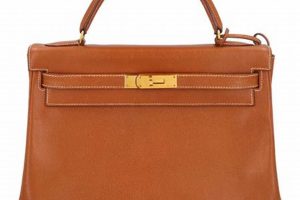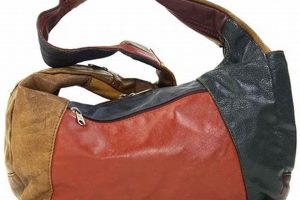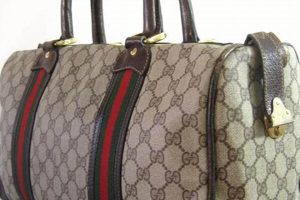Items within the realm of pre-owned Fendi accessories, particularly those from earlier decades, represent a distinct segment of the luxury goods market. These items, crafted by the Italian fashion house, are characterized by designs and materials reflective of past eras, offering a tangible connection to the brand’s history and evolving aesthetic.
Acquiring these pieces offers several advantages. Beyond their intrinsic value as luxury goods, they often appreciate in value due to rarity and historical significance. Moreover, owning such an item provides a unique opportunity to possess a tangible piece of fashion history, allowing individuals to express their personal style with an accessory that stands apart from contemporary trends. The pieces also represent a commitment to sustainability, promoting the circular economy by extending the lifespan of high-quality goods and reducing the demand for new production.
The following sections will delve into the identification and authentication of these prized possessions, explore key periods and iconic styles, and provide guidance on the proper care and preservation necessary to maintain their value and beauty.
Tips for Identifying Authentic Pre-Owned Fendi Handbags
The acquisition of pre-owned Fendi accessories requires careful consideration to ensure authenticity and value. Diligence in examining key characteristics is crucial.
Tip 1: Examine the Stitching: Consistent and uniform stitchwork is a hallmark of authentic Fendi craftsmanship. Inconsistencies, uneven spacing, or loose threads are indicators of a potential counterfeit.
Tip 2: Verify the Hardware: Genuine Fendi hardware features a high-quality finish and bears the brand’s logo or name. Inspect closures, buckles, and zippers for proper function and accurate branding. Examine the weight and feel; authentic hardware typically has a substantial feel.
Tip 3: Assess the Material Quality: Fendi utilizes premium materials such as leather, canvas, and hardware. Evaluate the texture, feel, and overall appearance of the materials for any signs of inferior quality. Leather should feel supple and high-quality, while canvas should be durable and uniformly woven.
Tip 4: Analyze the Lining: The interior lining of a genuine Fendi handbag is typically crafted from high-quality materials and features a distinct pattern or logo. Inspect the lining for irregularities, inconsistencies, or poor-quality fabric.
Tip 5: Scrutinize the Serial Number and Authenticity Card: Authentic Fendi bags include a serial number, usually located inside the bag, and an authenticity card. Verify that the serial number matches the style of the bag and that the card is present and in good condition. Cross-reference the serial number with Fendi’s database or consult with an authentication expert.
Tip 6: Evaluate the Overall Construction: The overall structure and construction of a genuine Fendi handbag are precise and meticulous. Examine the seams, edges, and corners for any signs of poor workmanship or structural flaws.
Tip 7: Consider the Seller’s Reputation: Purchase from reputable dealers or platforms specializing in pre-owned luxury goods. Investigate the seller’s history, read reviews, and request detailed photographs before making a purchase. Opt for sellers who offer authentication services or guarantees.
By carefully scrutinizing these aspects, the risk of acquiring a counterfeit Fendi handbag can be significantly reduced. Thorough inspection and due diligence are paramount in ensuring a valuable and authentic purchase.
The next section will delve into notable eras and iconic styles, further equipping the discerning collector with the knowledge necessary to navigate the world of pre-owned Fendi accessories.
1. Rarity of Design
Rarity of design is a key determinant of value and collectibility among pre-owned Fendi accessories. It denotes designs produced in limited quantities, styles specific to a particular season or collaboration, or models featuring unique materials or embellishments no longer in production. The inherent scarcity of these designs directly impacts their desirability and market value, influencing collectors’ pursuit and driving prices upward.
The connection between design rarity and value stems from fundamental economic principles of supply and demand. When the supply of a particular design is limited, and demand remains high, its perceived value increases. For example, a limited-edition Fendi Baguette bag from a collaboration with a renowned artist or a style featuring rare exotic skins commands a premium due to its scarcity. The identification of these scarce designs often requires specialized knowledge of Fendi’s historical collections and production cycles. Authentication and provenance documentation play a crucial role in verifying the design’s rarity and ensuring its legitimacy.
Understanding the relationship between design rarity and vintage Fendi handbags is of practical significance for both buyers and sellers. For buyers, it necessitates thorough research and careful assessment of the design’s origins and production history. For sellers, accurately identifying and documenting a design’s rarity is essential for pricing and marketing. Recognizing the unique characteristics of scarce models can inform strategic acquisition decisions, ultimately impacting investment returns and the preservation of valuable pieces of fashion history. However, accurately assessing rarity can be challenging, as counterfeiters often attempt to replicate sought-after designs. Expert authentication is crucial to mitigate this risk and ensure the legitimacy of the item.
2. Material Condition
The preservation of materials significantly dictates the value and collectibility of pre-owned Fendi handbags. The state of these materials directly reflects the item’s history, care, and long-term durability, impacting both its aesthetic appeal and structural integrity.
- Leather Integrity
Leather, a primary material in many Fendi handbags, is susceptible to wear, discoloration, and cracking. Significant scratches, stains, or dryness can diminish the item’s value. Regular conditioning and professional cleaning are essential for maintaining leather integrity. Items exhibiting minimal wear and supple, well-preserved leather command higher prices.
- Hardware Oxidation and Corrosion
Metal components, including clasps, zippers, and embellishments, can undergo oxidation or corrosion over time. These processes can affect the appearance and functionality of the hardware. Proper storage in a dry, temperature-controlled environment helps prevent oxidation. Replacing or refinishing damaged hardware requires expertise and can impact the item’s originality.
- Lining Wear and Tear
The interior lining of a vintage Fendi handbag is vulnerable to stains, tears, and general wear. The condition of the lining provides insights into the item’s usage and care. A clean, intact lining enhances the bag’s overall appeal and value, while significant damage necessitates professional repair or replacement.
- Stitching and Seam Stability
The integrity of stitching and seams is critical for maintaining the structural integrity of the handbag. Loose, broken, or missing stitches can compromise the bag’s shape and durability. Professional repairs, using materials and techniques consistent with the original construction, are necessary to restore seam stability and prevent further damage.
The material condition serves as a tangible record of its past. A well-preserved item offers a more authentic representation of its original design and craftsmanship. Therefore, meticulous assessment and appropriate care are imperative to maintaining the value and longevity of these coveted accessories.
3. Hardware Authenticity
The verification of hardware authenticity is a crucial step in evaluating pre-owned Fendi handbags. Hardware components often bear distinctive markings and characteristics that, when properly analyzed, can provide significant insights into the item’s origin and legitimacy.
- Logo Engravings and Stampings
Genuine Fendi hardware typically features precise and consistent logo engravings or stampings. These markings, often found on clasps, zippers, and buckles, exhibit specific fonts, spacing, and depth. Inconsistencies in these details, such as misaligned letters or shallow impressions, may indicate a counterfeit. Examination with a magnifying glass can reveal subtle discrepancies undetectable to the naked eye. Authentic engravings are sharp and well-defined, reflecting the brand’s commitment to quality.
- Material Composition and Finish
Fendi employs specific metal alloys and finishes for its hardware, often characterized by a substantial weight and a consistent color tone. Examination of the metal’s composition, using techniques such as X-ray fluorescence spectroscopy, can verify the authenticity of the materials. Inauthentic hardware may exhibit a lighter weight, a different color tone, or a tendency to tarnish or corrode more readily. The surface finish should be uniform and free from imperfections.
- Functional Integrity and Construction
Authentic Fendi hardware is designed for smooth and reliable functionality. Zippers should glide effortlessly, clasps should securely fasten, and buckles should operate without obstruction. The construction of the hardware, including the quality of the soldering and the precision of the assembly, should reflect high standards of craftsmanship. Faulty or poorly constructed hardware may indicate a counterfeit.
- Serial Numbers and Date Codes
Certain Fendi handbags feature serial numbers or date codes stamped or engraved onto the hardware. These codes can be cross-referenced with Fendi’s internal records to verify the item’s authenticity and manufacturing date. The presence of a serial number or date code, while not always a guarantee of authenticity, provides an additional data point for evaluation. The absence of such markings on models where they are expected is cause for concern.
The integration of these facets provides a comprehensive methodology for assessing hardware authenticity. Accurate evaluation of these elements, in conjunction with other authentication criteria, enhances the likelihood of acquiring genuine pre-owned Fendi accessories and mitigating the risk of purchasing counterfeit items. The presence of authentic hardware is a significant indicator of the overall legitimacy and value of the handbag.
4. Era Significance
The historical context in which Fendi handbags were designed and produced, termed here as “Era Significance,” profoundly impacts their value, collectibility, and cultural relevance. The prevailing fashion trends, economic conditions, and social norms of each era influenced the design, materials, and marketing of these accessories, imbuing them with a distinctive character. Understanding era significance is crucial for appreciating the evolution of Fendi’s aesthetic and for authenticating and valuing pieces.
- 1960s: The Rise of Fendi and Roman Chic
The 1960s witnessed the ascendancy of Fendi as a prominent name in Italian fashion. Bags from this era reflect the burgeoning “Roman chic” aesthetic, often characterized by refined leather craftsmanship, understated designs, and a focus on practicality. Examples include simple leather totes and structured handbags that catered to the demands of a modern, increasingly independent woman. The historical importance lies in these designs representing the brand’s formative years and its commitment to accessible luxury.
- 1970s: Experimentation with Materials and Bold Designs
The 1970s brought a period of experimentation and bold designs. Fendi bags from this era showcase a greater use of unconventional materials, such as fur and suede, alongside more vibrant color palettes. The introduction of the “FF” logo marked a significant moment in branding, appearing prominently on various handbag styles. The era reflects a shift towards a more flamboyant and expressive aesthetic, mirroring the broader cultural trends of the decade. Bags from this era represent Fendi’s willingness to embrace innovation and its growing international recognition.
- 1980s: Excess and Logo Mania
The 1980s saw an embrace of extravagance and logo mania, trends that heavily influenced Fendi’s handbag designs. Bags from this period are often characterized by larger sizes, bolder embellishments, and an overt display of the “FF” logo. Leather goods featured prominently, reflecting the decade’s emphasis on luxury and status symbols. These bags mirror the era’s penchant for excess and the rise of consumerism, representing a significant shift in the brand’s design direction.
- 1990s: The Baguette and the Dawn of “It” Bags
The 1990s marked a pivotal moment with the introduction of the Baguette bag, a design that catapulted Fendi into the realm of “It” bags. The Baguette, characterized by its small size, rectangular shape, and endless variations in materials and embellishments, became a cultural phenomenon. This era signifies Fendi’s ability to create a must-have accessory that transcended mere functionality, becoming a symbol of style and status. The Baguette bag remains an iconic design, representing Fendi’s enduring influence on the fashion landscape.
By understanding the era in which a specific handbag was created, collectors and enthusiasts gain valuable insights into its design influences, materials, and overall significance within the brand’s history. This contextual knowledge is essential for appreciating the evolution of Fendi’s aesthetic, authenticating vintage pieces, and assessing their value in the pre-owned market. Bags are an intersection of fashion, culture, and history, and understanding their origins enriches the experience of ownership.
5. Craftsmanship Quality
The assessment of craftsmanship quality is fundamental to evaluating vintage Fendi handbags, distinguishing authentic pieces from counterfeits and influencing their market value. The construction techniques, material selection, and attention to detail exhibited in these items reflect the brand’s commitment to excellence and contribute significantly to their lasting appeal.
- Stitching Precision and Uniformity
Consistent and uniform stitching is a hallmark of superior craftsmanship. Vintage Fendi handbags exhibit precise stitchwork with even spacing and secure thread tension. Deviation from this standard, such as inconsistent stitch length, loose threads, or visible knots, indicates compromised quality. For instance, the meticulous hand-stitching on a vintage Selleria bag exemplifies this facet. Such attention to detail ensures the bag’s structural integrity and enhances its aesthetic appeal.
- Hardware Integration and Finish
The seamless integration of hardware components, including clasps, zippers, and buckles, demonstrates a high level of craftsmanship. Authentic vintage Fendi hardware exhibits a smooth, even finish, devoid of blemishes or imperfections. The secure attachment of hardware, with no looseness or instability, is also critical. The use of high-quality materials, such as solid brass or precious metals, further enhances the overall craftsmanship quality. A vintage Baguette bag with a perfectly aligned and smoothly operating clasp illustrates this component.
- Edge Finishing and Treatment
The edges of leather panels on vintage Fendi handbags undergo careful finishing and treatment to enhance durability and aesthetic appeal. Common techniques include edge painting, burnishing, and folding. Clean, smooth edges, free from fraying or cracking, are indicative of superior craftsmanship. The consistent application of edge paint, with no drips or unevenness, further enhances the quality. A vintage Fendi Spy bag with impeccably finished edges exemplifies this facet, demonstrating the brand’s attention to detail.
- Lining Construction and Material
The interior lining of a vintage Fendi handbag is constructed with the same level of care and attention to detail as the exterior. The use of high-quality materials, such as silk, leather, or durable canvas, contributes to the overall craftsmanship quality. Precise stitching, secure seams, and a tailored fit ensure the lining’s longevity and prevent sagging or tearing. A vintage Fendi 2jours bag with a perfectly fitted and meticulously stitched silk lining is a testament to the brand’s commitment to interior craftsmanship.
The attributes collectively define the craftsmanship quality. Meticulous attention to detail, combined with the use of premium materials and skilled construction techniques, sets these bags apart. Evaluating these aspects is crucial for discerning authentic pieces from counterfeits and for appreciating the enduring legacy of Fendi’s craftsmanship. The vintage Fendi Handbags are great example.
Frequently Asked Questions
The following section addresses common inquiries regarding the acquisition, authentication, and care of pre-owned Fendi handbags, providing guidance for collectors and enthusiasts.
Question 1: How can the authenticity of a vintage Fendi handbag be definitively verified?
Authenticity verification requires a multifaceted approach. Examine the stitching, hardware, materials, and logo engravings for inconsistencies. Compare the serial number and date code against Fendi’s records. Consult with a reputable authentication service for expert assessment and certification. A comprehensive evaluation minimizes the risk of acquiring a counterfeit item.
Question 2: What factors contribute to the value appreciation of vintage Fendi handbags?
Value appreciation is influenced by several factors, including rarity of design, material condition, historical significance, and provenance. Limited-edition styles, bags in excellent condition, and pieces associated with specific eras or notable owners tend to command higher prices. Market demand and collector interest also play a crucial role.
Question 3: What are the essential steps for preserving the condition of a vintage Fendi handbag?
Preservation involves careful storage, regular cleaning, and professional maintenance. Store the bag in a dust bag, away from direct sunlight and humidity. Clean leather surfaces with a specialized leather cleaner and conditioner. Seek professional repair for any damage to stitching, hardware, or lining. Proper care ensures the bag’s longevity and value.
Question 4: Where are reliable sources for purchasing authentic pre-owned Fendi handbags?
Reputable sources include established auction houses, consignment stores specializing in luxury goods, and online marketplaces with rigorous authentication processes. Verify the seller’s reputation, review customer feedback, and request detailed photographs before making a purchase. Opt for sellers who offer authentication guarantees or return policies.
Question 5: How does the era of production impact the value and collectibility of a Fendi handbag?
The era of production significantly influences value. Bags from specific periods, such as the 1970s with their bold designs or the 1990s with the iconic Baguette, often command higher prices due to their historical significance and cultural relevance. Understanding the prevailing fashion trends and design influences of each era is crucial for assessing value.
Question 6: What are the most common signs of wear and tear to be aware of when evaluating a vintage Fendi handbag?
Common signs of wear and tear include scratches, stains, discoloration, and cracking on leather surfaces. Hardware may exhibit oxidation or corrosion. Stitching may be loose or broken. The lining may be torn or stained. A thorough inspection of these areas is essential for assessing the bag’s overall condition.
These frequently asked questions provide a framework for understanding the complexities of the vintage Fendi handbag market, emphasizing the importance of authentication, preservation, and informed decision-making.
The subsequent section will present a comparative analysis of different Fendi handbag styles across various eras, highlighting their distinct features and design elements.
Conclusion
The preceding analysis has explored the multifaceted nature of pre-owned Fendi accessories, encompassing authentication techniques, historical context, and preservation strategies. A thorough understanding of these elements is crucial for responsible acquisition and stewardship of these valuable items. The identification of genuine items, understanding their place in fashion history, and the diligent preservation of their materials ensures their longevity and value.
The acquisition of pre-owned luxury goods represents a commitment to both personal style and the principles of sustainability. Continued research, expert consultation, and informed decision-making remain essential for navigating the pre-owned market effectively. Appreciating the lasting impact of vintage Fendi bags requires recognizing the history and cultural relevance.







